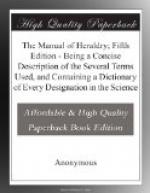Crests were used as marks of honour long before the introduction of Heraldry. The helmets and crests of the Greek and Trojan warriors are beautifully described by Homer. The German heralds pay great attention to crests, and depict them as towering to a great height above the helmet. Knights who were desirous of concealing their rank, or wished particularly to distinguish themselves either in the battle field or tourney, frequently decorated their helmets with plants or flowers, chimerical figures, animals, &c.; these badges were also assumed by their descendants. The difference between crests and badges as heraldic ornaments is, that the former are always placed on a wreath, in the latter they are attached to the helmet. The scroll is a label or ribbon containing the motto: it is usually placed beneath the shield and supporters; see the word MOTTO in the Dictionary.
CHAP. VI.
MARSHALLING CHARGES ON ESCUTCHEONS BY THE RULES OF HERALDRY.
The symbolic figures of Heraldry are so well known to those acquainted with the science in every kingdom of Europe, that if an Englishman was to send a written emblazonment or description of an escutcheon to a French, German, or Spanish artist acquainted with the English language, either of them could return a properly drawn and coloured escutcheon; but a correct emblazonment would be indispensable. A single word omitted would spoil the shield.
I.
The reader has already been informed that in emblazoning an escutcheon, the colour of the field is first named; then the principal ordinary, such as the fess, the chevron, &c., naming the tincture and form of the ordinary; then proceed to describe the charges on the field, naming their situation, metal, or colour; lastly, describe the charges on the ordinary.
II.
When an honourable ordinary or some one figure is placed upon another, whether it be a fess, chevron, cross, &c., it is always to be named after the ordinary or figure over which it is placed, with either the words surtout or overall.
III.
In the blazoning such ordinaries as are plain, the bare mention of them is sufficient; but if an ordinary should be formed of any of the curved or angular lines, such as invected, indented, &c., the lines must be named.
IV.
When a principal figure possesses the centre of the field, its position is not to be expressed; it is always understood to be in the middle of the shield.
V.
When the situation of a principal bearing is not expressed, it is always understood to occupy the centre of the field. Ex. See Azure, an annulet argent, p. 48. (Dictionary)




